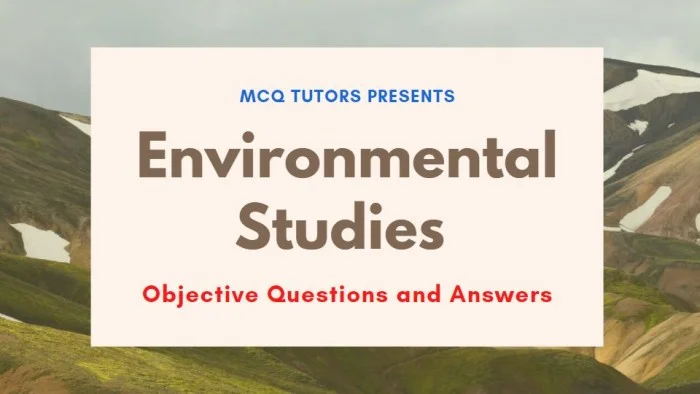The environmental studies program at a university offers students the opportunity to learn about the environment and how humans are affecting it.
Environmental studies strive to understand the relationships between humans and their environment. Does the field ask questions such as how do humans impact the planet? What can be done to improve the situation? What are some key principles of environmentalism?
To answer these questions, environmental studies professors often use objective questions. This document provides answers to some common objective questions used in environmental studies courses that will help you better understand what you are studying.

Environmental studies MCQ with answers
Ques. No 1. The wave of environmental concern swept our country since the Bhopal gas tragedy of ___.
A. 1980
B. 1981
C. 1982
D. 1984
Answer: D. 1984Answer:
Ques. No 2. The study of organisms in relation to their environment is termed as ___
A. Ecology
B. Environment study
C. Tastemaker
D. Atmosphere study
Answer: A. EcologyAnswer:
Ques. No 3. Water sphere” that includes all the water of the earth system is known as ___.
A. Hydrosphere
B. Atmosphere
C. Lithosphere
D. Biosphere
Answer: A. HydrosphereAnswer:
Ques. No 4. A ___ is the flow of energy from one organism to the next and to the next.
A. Earth chain
B. Food chain
C. Atmosphere chain
D. Pyramid chain
Answer: Answer:
B. Food chain
Ques. No 5. The study of the population is called ___.
A. Seismography
B. Demography
C. Populography
D. Biography
Answer: B. DemographyAnswer:
Ques. No 6. India’s population comprises approximately ___ of the world’s population.
A. One sixth
B. One fifth
C. One fourth
D. One third
Answer: A. One-sixthAnswer:
Ques. No 7. Small and medium enterprises contribute to ___ of the total industrial output.
A. 20%
B. 30%
C. 40%
D. 50%
Answer: C. 40%Answer:
Ques. No 8. ___ forms when sulfur dioxide and nitrous oxide transform into sulfuric acid and nitric acid in the atmosphere.
A. Global warming
B. Heavy rain
C. Ozone depletion
D. Acid rain
Answer: D. Acid rainAnswer:
Ques. No 9. ___was popularized in 1989 in a Scientific American article by Robert Frosch and
Nicholas E.
A. Industrial pollution
B. Industrial ecology
C. Pollution ecology
D. Ecology
Answer: B. Industrial ecologyAnswer:
Ques. No 10. The ___ absorbs UV radiation and protects the earth from the harmful effects of the sun’s UV radiation.
A. Ozone
B. Carbon Dioxide
C. Oxygen
D. Hydrogen
Answer: A. OzoneAnswer:
Ques. No 11. The first severe air pollution occurred in the Meuse Valley of Belgium in ___.
A. 1940
B. 1930
C. 1950
D. 1960
Answer: B. 1930Answer:
Ques. No 12. “Minamata disease in Japan (1950) was caused due to ___ poisoning.
A. Ethyl mercury poisoning
B. Mercury poisoning
C. Methyl mercury poisoning
D. Dimethyl mercury poisoning
Answer: C. Methyl mercury poisoningAnswer:
Ques. No 13. ___ includes oil, pesticides, detergents, synthetic organic compounds, plant nutrients, etc.
A. Thermal pollutants
B. Radioactive materials
C. Inorganic pollutants
D. Organic Pollutants
Answer: D. Organic PollutantsAnswer:
Ques. No 14. Most industrial furnaces give rise to a grey, powder residue of unburned material called ___.
A. Ash
B. Ash residue
C. Ash fly
D. Fly ash
Answer: D. Fly ashAnswer:
Ques. No 15. The name ___ from the Spanish for “the little boy”, refers to the Christ child.
A. Al Niño
B. De Niño
C. La Niño
D. El Niño
Answer: D. El NiñoAnswer:
Ques. No 16. ___ is associated with floods, droughts, and other disturbances in a range of locations around the world.
A. PDO
B. ENSO
C. IPO
D. WHO
Answer: B. ENSOAnswer:
Ques. No 17. At the Montreal conference and London Conference, it was decided that the developed countries would totally ban CFC production by ___.
A. 2000
B. 1990
C. 1995
D. 1996
Answer: A. 2000Answer:
Ques. No 18. United Nations Conference on the Human Environment was held at ___ in June 1972.
A. London
B. Delhi
C. Sydney
D. Stockholm
Answer: D. StockholmAnswer:
Ques. No 19. The PH value of the water for wet processing should be ___.
A. 1 to 2
B. 3 to 4
C. 5 to 6
D. 7 to 8
Answer: D. 7 to 8Answer:
Ques. No 20. Hazardous or toxic wastes are a subgroup of ___.
A. Hard to treat wastes
B. Dispersible wastes
C. High volume wastes
D. Nondispersible wastes
Answer: A. Hard to treat wastesAnswer:
Ques. No 21. The main components of an ecosystem are ___ and ___.
A. Biotic, Cbiotic
B. Non biotic, Abiotic
C. Biotic, Abiotic
D. Abiotic, Dbiotic
Answer: C. Biotic, AbioticAnswer:
Ques. No 22. State True or False:
i) Auto ecology deals with the study of individual organisms or individual species in relation to the environment.
ii) Study of groups of organisms, which are associated with each other as a unit in relation to their total environment is termed Synecology.
A. i. True, ii. True
B. i. False, ii. True
C. i. True, ii. False
D. i. False, ii. False
Answer: A. i. True, ii.TrueAnswer:
Ques. No 23. ___ is the lowest layer of the earth’s atmosphere while ___ is the second layer of the atmosphere.
A. Stratosphere, Mesosphere
B. Troposphere, Ionosphere
C. Troposphere, Stratosphere
D. Mesosphere, Stratosphere
Answer: C. Troposphere, StratosphereAnswer:
Ques. No 24. Which of the following gases emitted by the industries result in acid rain?
A. NO, CO2
B. SO2, CO
C. NO2, CO2
D. CO, CO2
Answer: B. SO2, COAnswer:
Ques. No 25. State True or False:
i) The most recent census of India was performed in the year 2022 for enumeration as of March 1 of that year.
ii) To meet the demands of the growing population in terms of food and amenities, rapid industrialization becomes necessary.
A. i. True, ii.False
B. i. True, ii. True
C. i. False, ii.True
D. i. False, ii. False
Answer: C. i. False, ii.TrueAnswer:


